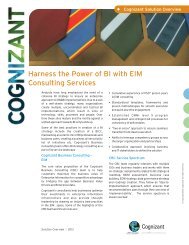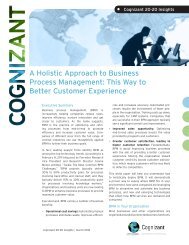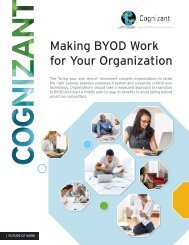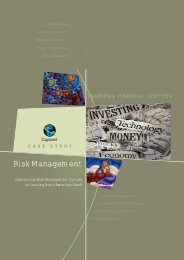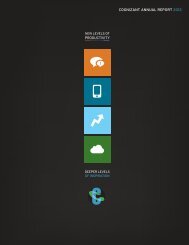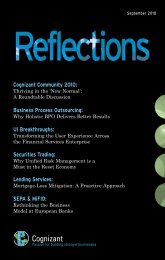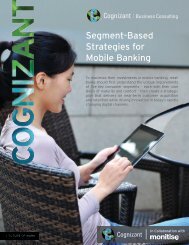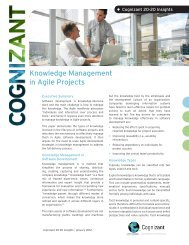The 21st Century CIO -- Leading IT Transformation in a ... - Cognizant
The 21st Century CIO -- Leading IT Transformation in a ... - Cognizant
The 21st Century CIO -- Leading IT Transformation in a ... - Cognizant
You also want an ePaper? Increase the reach of your titles
YUMPU automatically turns print PDFs into web optimized ePapers that Google loves.
manage its applications portfolio and its full lifecycle software development needs, <strong>in</strong>clud<strong>in</strong>g ma<strong>in</strong>tenance and test<strong>in</strong>g. <strong>The</strong> netresult: 75% of the <strong>in</strong>ternal <strong>IT</strong> organization function was outsourced, and its operational performance cont<strong>in</strong>ues to improve.<strong>The</strong> company also brought <strong>in</strong> a new <strong>CIO</strong> whose mission is to lead this radical transformation. He placed a high priority on moreclosely align<strong>in</strong>g <strong>IT</strong> with the bus<strong>in</strong>esses and transform<strong>in</strong>g the <strong>IT</strong> organization <strong>in</strong>to a source of competitive advantage. <strong>Cognizant</strong>was <strong>in</strong>strumental <strong>in</strong> help<strong>in</strong>g this <strong>CIO</strong> develop, plan and implement the various components of this <strong>in</strong>itiative, which is see<strong>in</strong>g greatprogress today.<strong>CIO</strong> Makeover<strong>The</strong> <strong>CIO</strong> at this Fortune 100 company is a great example of the type of leader needed to effect quantum <strong>IT</strong> transformation. He’s apositive th<strong>in</strong>ker, capable of motivat<strong>in</strong>g his team and align<strong>in</strong>g them with his agenda. He is also focused on strategic rather thantactical concerns, yet drives his teams to develop roll<strong>in</strong>g plans to implement their strategic objectives.At many organizations -- <strong>in</strong>clud<strong>in</strong>g the company cited above -- <strong>IT</strong> has historically operated without an explicit strategic plan <strong>in</strong>place. So a natural start<strong>in</strong>g po<strong>in</strong>t for the <strong>CIO</strong> <strong>in</strong> a transformative environment is align<strong>in</strong>g and def<strong>in</strong><strong>in</strong>g the <strong>IT</strong> strategy and help<strong>in</strong>gto determ<strong>in</strong>e the organization’s goals and objectives. This allows the <strong>CIO</strong> to beg<strong>in</strong> manag<strong>in</strong>g the <strong>IT</strong> portfolio to maximizereturn on <strong>in</strong>vestment. Enabl<strong>in</strong>g this requires a strong approach to portfolio management, and perhaps even establish<strong>in</strong>g orreshap<strong>in</strong>g an exist<strong>in</strong>g project management office or team. In the case of the consumer goods company, <strong>Cognizant</strong> worked to centralizeprogram management and create better governance and metrics by reorganiz<strong>in</strong>g the office of project management to alignbetter with the new <strong>IT</strong> structure.<strong>CIO</strong>s need to rise above the status quo andtake on a new set of activities that has them<strong>in</strong>volved <strong>in</strong> the strategy developmentprocess from the get-go.A third strategic role is design<strong>in</strong>g an enterprise architecture that enables bus<strong>in</strong>ess agility. Although this requires a hefty upfront<strong>in</strong>vestment, the speed of change that most companies require cannot be supported without a flexible, agile technologyarchitecture. <strong>IT</strong> leaders who boldly take on these challenges are, <strong>in</strong> our view, progressive “<strong>21st</strong> <strong>Century</strong> <strong>CIO</strong>s.” <strong>The</strong>y are amongthe few <strong>CIO</strong>s who are well-armed and positioned to effect the quantum change required to transform their organizations <strong>in</strong>tostrategically-valued partners.Help<strong>in</strong>g Transform <strong>The</strong> Bus<strong>in</strong>essChange-effect<strong>in</strong>g <strong>CIO</strong>s drive <strong>in</strong>creas<strong>in</strong>g <strong>in</strong>teraction between their <strong>IT</strong> departments and the bus<strong>in</strong>ess units, thereby <strong>in</strong>creas<strong>in</strong>g <strong>IT</strong>’sacceptance by the bus<strong>in</strong>ess. To accomplish this, they need to connect <strong>in</strong>creas<strong>in</strong>gly with the CEO, their bus<strong>in</strong>ess peers and theirdirect reports. It’s only by discover<strong>in</strong>g what is truly driv<strong>in</strong>g the bus<strong>in</strong>ess that they’ll beg<strong>in</strong> to recognize <strong>in</strong>novative ways to usetechnology to drive competitive advantage. In this newly elevated position, they can beg<strong>in</strong> educat<strong>in</strong>g the enterprise on whattechnology is and isn’t capable of do<strong>in</strong>g, with<strong>in</strong> the organization’s budgetary, architectural and strategic limits. <strong>The</strong>y can alsobeg<strong>in</strong> to not just support but also genu<strong>in</strong>ely lead bus<strong>in</strong>ess change.To <strong>in</strong>ternalize a desired level of bus<strong>in</strong>ess understand<strong>in</strong>g with<strong>in</strong> the DNA of the <strong>IT</strong> department, the various functional leaders --along with members of vital groups such as bus<strong>in</strong>ess partners, program management, enterprise architecture and <strong>in</strong>frastructure-- should be urged to follow a structured program to <strong>in</strong>crease their knowledge and experience of the world <strong>in</strong> which the bus<strong>in</strong>essunits operate. Such a program would typically start with an understand<strong>in</strong>g of the end-to-end bus<strong>in</strong>ess system of the company. Forexample, <strong>in</strong> a product-oriented firm, participants should <strong>in</strong>clude divisions such as purchas<strong>in</strong>g, R&D, production, distribution,market<strong>in</strong>g, sales, service and the competitive and product-market environments <strong>in</strong> which the bus<strong>in</strong>ess units compete globally.<strong>The</strong> program should also <strong>in</strong>clude a “day <strong>in</strong> the life” menu of bus<strong>in</strong>ess activities that <strong>IT</strong> personnel should experience first-hand.For <strong>in</strong>stance, <strong>in</strong> a soft dr<strong>in</strong>ks company, this could <strong>in</strong>clude rid<strong>in</strong>g with delivery representatives, observ<strong>in</strong>g a production l<strong>in</strong>e orexperienc<strong>in</strong>g first-hand the company’s markets <strong>in</strong> Ch<strong>in</strong>a, India or Brazil. Further down the road, it could <strong>in</strong>clude <strong>IT</strong> directors andkey managers attend<strong>in</strong>g the non-<strong>IT</strong> forums and conferences recommended by bus<strong>in</strong>ess units as these are important ways ofkeep<strong>in</strong>g abreast of market developments and <strong>in</strong>teract<strong>in</strong>g with customers and competitors.2
To transition from thought to action, the <strong>CIO</strong> needs to <strong>in</strong>ternalize the CEO’s and board’s strategic agenda, and should consequentlyspend a great deal of time and effort with key peers -- the head of Corporate Strategy and Corporate Development, the heads ofthe BUs as well as their key planners, and of course the CFO. It would not be a bad idea for the <strong>CIO</strong> to accompany some of theseleaders on their <strong>in</strong>ternal visits, as well as on their external <strong>in</strong>teractions with customers, suppliers and<strong>in</strong>dustry forums (similar to the “day <strong>in</strong> the life” mandate for the <strong>CIO</strong>’s staff). Ultimately the <strong>CIO</strong> facesthe same test as his/her bus<strong>in</strong>ess partner organization does -- ga<strong>in</strong><strong>in</strong>g the trust of peers and be<strong>in</strong>gseen by them as add<strong>in</strong>g value or competitive advantage <strong>in</strong>stead of “runn<strong>in</strong>g the <strong>IT</strong> department.”<strong>The</strong> traditional structure of most <strong>IT</strong> organizations, however, is not equipped to meet newbus<strong>in</strong>ess imperatives. <strong>The</strong> <strong>21st</strong> <strong>Century</strong> <strong>CIO</strong> provides the high-level vision, as well as theempower<strong>in</strong>g and syndicat<strong>in</strong>g skills, to restructure <strong>IT</strong> to more effectively serve complex, globalbus<strong>in</strong>ess organizations. At the aforementioned client company, for <strong>in</strong>stance, the <strong>CIO</strong>restructured <strong>IT</strong> to better match the company’s matrix structure. It is also essential to adopt newprocesses, roles and skills for the <strong>IT</strong> staff, which sometimes <strong>in</strong>volves select<strong>in</strong>g and manag<strong>in</strong>gnew sourc<strong>in</strong>g options.To succeed <strong>in</strong> today’s global fast-chang<strong>in</strong>g environment, the most effective <strong>CIO</strong>s are part Zen Master orpositive re<strong>in</strong>forcer; part strategist and <strong>in</strong>novator, or driver of change for the better; preferably someone who has experienced lifeon the bus<strong>in</strong>ess side; and an effective communicator. She’s a positive th<strong>in</strong>ker, capable of motivat<strong>in</strong>g her team and align<strong>in</strong>g themwith her agenda. She is also focused on strategic rather than tactical concerns, yet drives her teams to develop roll<strong>in</strong>g plans toimplement their strategic objectives.A Phased ApproachAs previously noted, the prescriptions for radical transformation are best digested <strong>in</strong>crementally. <strong>Cognizant</strong> identifies threedist<strong>in</strong>ct states <strong>in</strong> which <strong>IT</strong> organizations operate: <strong>The</strong> traditional role of technology supplier; the more engaged role of bus<strong>in</strong>essenabler; and the fully realized role of strategically valued partner. As the <strong>IT</strong> organization evolves from one to the next, there arealso two correspond<strong>in</strong>g phases of the journey. First, <strong>IT</strong> moves from a technology supplier to a bus<strong>in</strong>ess enabler, actively manag<strong>in</strong>grelationships with the bus<strong>in</strong>ess units. In the second phase, <strong>IT</strong> ultimately becomes a strategically valued partner. Let’s take a closerlook at these phases, through our work with this consumer goods manufacturer (see Figure 1, next page).Phase I: From Supplier to EnablerOther than <strong>in</strong> the bank<strong>in</strong>g and f<strong>in</strong>ancial services <strong>in</strong>dustries, which are more highly evolved from a strategic <strong>IT</strong> perspective, mostcorporations operate as if their <strong>IT</strong> resources merely provide and ma<strong>in</strong>ta<strong>in</strong> bus<strong>in</strong>ess applications and their accompany<strong>in</strong>g<strong>in</strong>frastructure and support. In this <strong>in</strong>itial stage, we have observed that <strong>IT</strong> departments are viewed <strong>in</strong> the traditional role of supplier,provid<strong>in</strong>g technical resources, deliver<strong>in</strong>g projects and support<strong>in</strong>g users, with little <strong>in</strong>volvement <strong>in</strong> day-to-day operations of thebus<strong>in</strong>ess units and none <strong>in</strong> sett<strong>in</strong>g bus<strong>in</strong>ess priorities.In our experience, these groups often function as order takers and are often blamed when systems don’t achieve the desired levelof success or when projects are over-budget. <strong>The</strong>y therefore need to be motivated and overhauled to be more closely aligned withthe bus<strong>in</strong>ess and more <strong>in</strong>volved <strong>in</strong> strategic plann<strong>in</strong>g.Our first recommendation to this Fortune 100 client was to improve <strong>IT</strong>’s performance, timel<strong>in</strong>ess and cost of deliver<strong>in</strong>g the basicneeds of the bus<strong>in</strong>ess units. This typically <strong>in</strong>volves review<strong>in</strong>g, potentially restructur<strong>in</strong>g and implement<strong>in</strong>g sound governance andmetrics with<strong>in</strong> vital functional areas of the <strong>IT</strong> department, <strong>in</strong>clud<strong>in</strong>g enterprise architecture, program/project management, bus<strong>in</strong>esspartners and <strong>IT</strong> processes. Such <strong>in</strong>itiatives are prefaced by communicat<strong>in</strong>g an understand<strong>in</strong>g of the long view by senior <strong>IT</strong>management, to convey its ultimate goal to function as a source of competitive advantage to the bus<strong>in</strong>ess (see Figure 2, page 3).Such transformative <strong>in</strong>itiatives with<strong>in</strong> large organizations typically result <strong>in</strong> a temporary dip <strong>in</strong> performance before start<strong>in</strong>g toga<strong>in</strong> momentum and yield<strong>in</strong>g the benefits targeted by the quantum change. This should not deter the <strong>IT</strong> leadership team or thepeople who work with them; rather, it should be recognized as an <strong>in</strong>evitable short-term consequence of radical organizationalchange. In our client example, <strong>Cognizant</strong> advised the company to expect short-term degradation of <strong>IT</strong> performance dur<strong>in</strong>g the movefrom supplier to enabler. This is natural, due to the disruptions of gett<strong>in</strong>g the organization up to speed and prepared for the PhaseI transition, dur<strong>in</strong>g which cont<strong>in</strong>uous <strong>IT</strong> improvements will beg<strong>in</strong> to be seen.3
FIGURE 1:<strong>IT</strong> Goals and Realities <strong>in</strong> a Quantum Change Environment<strong>IT</strong> as a strategic partnerValue enhancementthrough <strong>IT</strong> transformationAt<strong>in</strong>ceptionShort-term distruptiondue to quantum changeCont<strong>in</strong>uous <strong>IT</strong>improvementsPhase IPhase I<strong>IT</strong>ime<strong>IT</strong> as a supplier <strong>IT</strong> as a bus<strong>in</strong>ess enabler <strong>IT</strong> as a strategicallyvalued partnerNext, <strong>in</strong> conjunction with a newly reorganized program management organization, we helped the bus<strong>in</strong>ess <strong>in</strong>terfac<strong>in</strong>g groupdevelop a plan to help it transition through the two phases. A key step was gett<strong>in</strong>g them to the table when the bus<strong>in</strong>ess unitsheld their strategic plann<strong>in</strong>g sessions. This particular company’s corporate and bus<strong>in</strong>ess unit strategic plann<strong>in</strong>g processes werevery well-def<strong>in</strong>ed, so we identified specific po<strong>in</strong>ts throughout the annual plann<strong>in</strong>g cycle when the bus<strong>in</strong>ess <strong>in</strong>terfac<strong>in</strong>g partnersshould participate. And <strong>in</strong> order to more effectively participate, we recommended that the bus<strong>in</strong>ess partners understand and<strong>in</strong>ternalize the exist<strong>in</strong>g strategic plan of their correspond<strong>in</strong>g bus<strong>in</strong>ess unit.After <strong>in</strong>itial meet<strong>in</strong>gs, the bus<strong>in</strong>ess <strong>in</strong>terfac<strong>in</strong>g partners translated the goals, objectives and strategies of their bus<strong>in</strong>ess units <strong>in</strong>toa correspond<strong>in</strong>g <strong>IT</strong> strategy and presented it to the strategic planners of the bus<strong>in</strong>ess units. A bus<strong>in</strong>ess unit’s <strong>IT</strong> strategy reflectsits unique realities and needs, subject to corporate constra<strong>in</strong>ts, such as bus<strong>in</strong>ess imperatives and strategy, budgets and enterprisearchitectural standards. We prepared the <strong>IT</strong> participants to be thick-sk<strong>in</strong>ned about the reaction they would <strong>in</strong>itially receive.While some of the bus<strong>in</strong>ess units were very open to <strong>IT</strong>’s desire to help drive strategy development, many had no experience toballast their trust that <strong>IT</strong> was qualified to play such a role. This is not unique to this particular company. <strong>The</strong> first few times any<strong>IT</strong> group plays this type of role, it should prepare to be criticized -- particularly if team members haven’t yet developed a reputationAchiev<strong>in</strong>g Enabler StatusTo transition from supplier to enabler, organizations need to consider the follow<strong>in</strong>g:nnnnIn the near term, improve on the delivery of bus<strong>in</strong>ess needs.Key <strong>IT</strong> groups such as bus<strong>in</strong>ess <strong>in</strong>terfac<strong>in</strong>g partners, program/project managementand enterprise architecture must develop a transition plan to move from a deliveryto a strategic role.Create and execute the renewal plans while meet<strong>in</strong>g basic bus<strong>in</strong>ess needs first.Start develop<strong>in</strong>g each bus<strong>in</strong>ess unit's <strong>IT</strong> strategic plan, after bus<strong>in</strong>ess <strong>in</strong>terfacepartners ga<strong>in</strong> a basic understand<strong>in</strong>g of the bus<strong>in</strong>ess unit strategy and become<strong>in</strong>volved <strong>in</strong> the bus<strong>in</strong>ess units' strategic plann<strong>in</strong>g processes.2
FIGURE 2:Functional Areas that Drive <strong>IT</strong> Renewal<strong>The</strong> partner organizationassists bus<strong>in</strong>ess <strong>in</strong> align<strong>in</strong>g<strong>IT</strong> strategy with bus<strong>in</strong>essstrategy and needs to buildcapabilities that enable it toshare the bus<strong>in</strong>ess strategydef<strong>in</strong>ition forum.Identification of the correctBI tool to address thepresent and projectedfuture needs of anorganization topreempt trendsand forecasts whileenhanc<strong>in</strong>gbus<strong>in</strong>ess value.Multiple PMOsimpact project portfolioma<strong>in</strong>tenance process.A centralized PMOfacilitates project plann<strong>in</strong>gand prioritization, enabl<strong>in</strong>g<strong>IT</strong> to ga<strong>in</strong> project buy-<strong>in</strong>from the bus<strong>in</strong>ess and, later,manage the project.Identification ofservices andcomposition of<strong>in</strong>frastructure spendand development of amodel to forecast<strong>in</strong>frastructure service needs.Strategic<strong>IT</strong> Plann<strong>in</strong>gManag<strong>in</strong>g the overalltransformation <strong>in</strong> <strong>IT</strong> requiresan effective governancemodel to address the chang<strong>in</strong>gbus<strong>in</strong>ess needs and processesof an organization.Alignment of <strong>IT</strong> withbus<strong>in</strong>ess demandshav<strong>in</strong>g an enterprisearchitecture witha portfolio ofapplications thatresolve bus<strong>in</strong>essneeds efficiently.for be<strong>in</strong>g able to deliver this type of capability. In many companies, <strong>IT</strong> has never attended a strategy meet<strong>in</strong>g, and if it has, it oftenhas little to contribute, sometimes risk<strong>in</strong>g alienation by charg<strong>in</strong>g the bus<strong>in</strong>ess for its time. <strong>The</strong>refore, the skills and experience ofbus<strong>in</strong>ess <strong>in</strong>terfac<strong>in</strong>g partners are important -- people with greater bus<strong>in</strong>ess savvy and cross-functional expertise should assumethese roles. Eventually, after persever<strong>in</strong>g through one or two annual cycles, our experience has shown that <strong>IT</strong> can expect to beseen as add<strong>in</strong>g value and will be more readily accepted at the strategic plann<strong>in</strong>g table. It’s only over time that <strong>IT</strong> will beg<strong>in</strong> to beseen as a bus<strong>in</strong>ess enabler. If slow and steady w<strong>in</strong>s the race, then steady and earnest w<strong>in</strong>s the trust.Phase II: From Enabler to Strategically Valued PartnerWith the above <strong>in</strong>itiatives <strong>in</strong> process, a company like our Fortune 100 consumer goods client is prepared for Phase II -- the transitionfrom enabler to strategically valued <strong>IT</strong> partner. When these <strong>in</strong>itiatives have taken hold, this client will jo<strong>in</strong> the small but grow<strong>in</strong>granks of <strong>IT</strong> organizations that are lead<strong>in</strong>g their companies through quantum change.As an effective bus<strong>in</strong>ess enabler, <strong>IT</strong>now has the ability to respond appropriatelyto the many <strong>in</strong>cidental projects generatedby middle management.In the second phase, bus<strong>in</strong>ess <strong>in</strong>terfac<strong>in</strong>g groups will have successfully completed three to five strategic plann<strong>in</strong>g cycles with thebus<strong>in</strong>ess units. <strong>The</strong>y will have <strong>in</strong>ternalized the bus<strong>in</strong>ess units’ strategies, become embedded <strong>in</strong> the bus<strong>in</strong>ess units’ strategicplann<strong>in</strong>g processes and developed a reputation as vital partners <strong>in</strong> execut<strong>in</strong>g the strategic plan. Throughout this step, the bus<strong>in</strong>ess<strong>in</strong>terfac<strong>in</strong>g groups will cont<strong>in</strong>uously seek bus<strong>in</strong>ess guidance <strong>in</strong> the face of negative feedback.Phase II transition <strong>in</strong>corporates alignment of an organization’s maturity <strong>in</strong> terms of its growth/profitability, with a strategicallysupportive <strong>IT</strong> environment. This <strong>in</strong>volves channel<strong>in</strong>g <strong>IT</strong> <strong>in</strong>novation to support operational excellence and knowledge workerproductivity. For example, with<strong>in</strong> cyclically mature and slower-growth <strong>in</strong>dustries such as truck manufactur<strong>in</strong>g, a strategicallysupportive <strong>IT</strong> environment would facilitate stability and control, whereas with<strong>in</strong> hyper-growth social network<strong>in</strong>g companies, the3
<strong>IT</strong> emphasis would be on agility and transportability <strong>in</strong> order to enable rapid development of new geographic markets. <strong>The</strong>refore,companies such as MySpace and eBay operate <strong>in</strong> platform-agnostic environments, so that application development can be alignedto drive bus<strong>in</strong>ess growth.In this evolved phase, goal alignment workshops are well-established strategic forums, and <strong>IT</strong> leadership is conditioned to askthe right questions and come to the table with answers. In such best-of-breed companies, important strategic <strong>IT</strong> processes <strong>in</strong> place<strong>in</strong>clude:n M&A SupportFollow<strong>in</strong>g the examples of corporations that have been highly active and evolved <strong>in</strong> M&A activity, such as Bank of Americaand MetLife, strategically valued <strong>IT</strong> departments use a detailed playbook to rapidly identify and conduct all aspects of duediligence on a potential target. <strong>The</strong>n, if the deal is done, the playbook is utilized to <strong>in</strong>tegrate it seamlessly to the benefit ofall its stakeholders. In the most effective situations, M&A task forces from different functional areas of the corporationapply procedurally standardized (though functionally dist<strong>in</strong>ct) parts of the playbook to work seamlessly together <strong>in</strong> the<strong>in</strong>tegration (or divestiture) exercise.n Advanced Vendor Partner<strong>in</strong>gIn strategically valued <strong>IT</strong> departments, the leadership team has greatly improved its effectiveness by disown<strong>in</strong>g <strong>IT</strong>application, support and <strong>in</strong>frastructure -- treat<strong>in</strong>g them as services and lett<strong>in</strong>g external partners deliver them. This enablessenior <strong>IT</strong> leaders to focus on improv<strong>in</strong>g the company’s competitive position, mak<strong>in</strong>g the <strong>IT</strong> <strong>in</strong>vestments that are unique tothe bus<strong>in</strong>ess and that can differentiate it from the competition. Companies <strong>in</strong> various <strong>in</strong>dustries that were born <strong>in</strong> the Internetage, such as Netflix, eBay and Amazon, have each downplayed ownership of application support and ma<strong>in</strong>tenance, and<strong>in</strong>stead focused their <strong>IT</strong> efforts to facilitate leadership positions <strong>in</strong> their <strong>in</strong>dustries.n Effective Service-Oriented ArchitecturesInitially, service-oriented architectures (SOAs) made it possible for <strong>IT</strong> departments to create more flexible connections acrossapplications. Just as automobile companies have become familiar with modular product design, a number of large banksand f<strong>in</strong>ancial service firms now utilize service-oriented architectures to implement modular bus<strong>in</strong>ess processes. This allowsresource providers to facilitate both process <strong>in</strong>novation and responsiveness to chang<strong>in</strong>g markets on the fly. Strategicallyvalued <strong>IT</strong> departments make <strong>in</strong>vestments to significantly improve the effectiveness of their SOAs.n Non-Siloed Bus<strong>in</strong>ess Intelligence CapabilitiesFor the most part, bus<strong>in</strong>ess <strong>in</strong>telligence (BI) capabilities are still heavily siloed with<strong>in</strong> <strong>IT</strong> departments and address a narrowband of bus<strong>in</strong>ess users. Strategically valued <strong>IT</strong> departments propagate a democratized enterprise “<strong>in</strong>telligence platform”throughout the organization. In such companies, data is available to a broad spectrum of users through many different<strong>in</strong>terfaces. Oil & gas and pharmaceutical firms <strong>in</strong> particular are lead<strong>in</strong>g the way <strong>in</strong> distribut<strong>in</strong>g BI capabilities throughout theirorganizations.n Systematized Strategic Plann<strong>in</strong>gRecall<strong>in</strong>g the ratio of perspiration to <strong>in</strong>spiration, an effective strategic plann<strong>in</strong>g regime is 20 parts deregulated <strong>in</strong>novation,technology and competitor analysis, and 80 parts regulated plann<strong>in</strong>g discipl<strong>in</strong>e. Regulated strategic plann<strong>in</strong>g capabilities,<strong>in</strong> turn, <strong>in</strong>corporate the capacity to focus on the agenda for change, as well as to react with agility to stochastic events, suchas a fast-break<strong>in</strong>g acquisition opportunity or an <strong>in</strong>ternal crisis. However, discipl<strong>in</strong>e also serves to <strong>in</strong>ject rigor <strong>in</strong>to annualplann<strong>in</strong>g cycles, provide close coord<strong>in</strong>ation with corporate and bus<strong>in</strong>ess unit plann<strong>in</strong>g efforts, and syndicate plans throughoutthe organization <strong>in</strong> order to realize the values implicit <strong>in</strong> them (see Figure 3, next page).n Proactive Organizational Change ManagementStrategically valued <strong>IT</strong> departments are also responsible for change management with<strong>in</strong> their organizations. <strong>Cognizant</strong>’s work withthe aforementioned company not only helped it frame a change management methodology from an <strong>in</strong>ternal <strong>IT</strong> perspective, but italso provided an opportunity to build an agile <strong>IT</strong> organization to cont<strong>in</strong>uously implement advancements <strong>in</strong> bus<strong>in</strong>ess drivers andimprovements <strong>in</strong> mission-critical bus<strong>in</strong>ess processes.
FIGURE 3:A Representative Strategic Plann<strong>in</strong>g FrameworkStructureProcessConduct Situation AnalysisFeedback fromExecutionDevelopStrategyExperiment & Implement(engage withBUs)Def<strong>in</strong>e/Ref<strong>in</strong>e StrategicChoices & VisionExecuteInitiateMetrics & RewardsPeople ProcessCulture3
Everyone Plays A RoleAn effective <strong>CIO</strong> is crucial to this type of transformation, but success requires contributions from many <strong>IT</strong> groups. With<strong>in</strong> ourexample company, ideas are channeled through advocates among bus<strong>in</strong>ess <strong>in</strong>terfac<strong>in</strong>g partners, program/project management,enterprise architecture, organizational governance, <strong>in</strong>frastructure, enterprise bus<strong>in</strong>ess <strong>in</strong>telligence and others, and they are thenpruned and encapsulated to be aligned with the strategies of the bus<strong>in</strong>ess units. While all groups are expected to contribute aforward-th<strong>in</strong>k<strong>in</strong>g plan, some groups play a more dom<strong>in</strong>ant role than others <strong>in</strong> guid<strong>in</strong>g the overall strategy. For <strong>in</strong>stance, decisionsmade by the bus<strong>in</strong>ess <strong>in</strong>terfac<strong>in</strong>g partners, enterprise architecture and the PMO def<strong>in</strong>e the strategy of the entire <strong>IT</strong> organizationand establish how well <strong>in</strong>itiatives are executed.Initiat<strong>in</strong>g a quantum change <strong>in</strong>itiative is not easy,and not every company is ready for a total <strong>IT</strong>transformation.Persistence is required to achieve quantum change <strong>in</strong> either the big-bang or small-bites mode. <strong>The</strong> trade-off is that persistencemay be harder to susta<strong>in</strong> <strong>in</strong> the small-bites approach, s<strong>in</strong>ce progress and visibility are harder to gauge by others with<strong>in</strong> theorganization. Success requires heightened vigilance by the <strong>CIO</strong> (or a lieutenant with good strategic experience/m<strong>in</strong>dset), In eithercase, it is essential that a well articulated and communicated strategic <strong>IT</strong> plan be developed and ma<strong>in</strong>ta<strong>in</strong>ed -- one that is closelyaligned with corporate and BU strategy.Mov<strong>in</strong>g through the two phases from technology supplier to strategic partner is a necessary structural transformation that opensup new horizons for <strong>IT</strong> leaders and the organizations they manage. It creates opportunities for the advocates and entrepreneurs<strong>in</strong>volved, position<strong>in</strong>g <strong>IT</strong> to play a key role <strong>in</strong> def<strong>in</strong><strong>in</strong>g and implement<strong>in</strong>g enterprise and bus<strong>in</strong>ess unit strategy, while elevat<strong>in</strong>g theoverall market value of <strong>IT</strong>.V<strong>in</strong>eet Kapur is a Pr<strong>in</strong>cipal <strong>in</strong> <strong>Cognizant</strong>’s Bus<strong>in</strong>ess Consult<strong>in</strong>g group (CBC). V<strong>in</strong>eet has over 25 years of experience <strong>in</strong> corporate andbus<strong>in</strong>ess strategy, mergers and acquisitions, f<strong>in</strong>ance and management consult<strong>in</strong>g. Prior to jo<strong>in</strong><strong>in</strong>g <strong>Cognizant</strong> he was the CFO ofTouchstone Asset Management. He was previously a Corporate Development Specialist at McK<strong>in</strong>sey & Company, specializ<strong>in</strong>g <strong>in</strong>embedded cross-functional engagements with<strong>in</strong> the healthcare, <strong>in</strong>formation technology, f<strong>in</strong>ancial services, media/enterta<strong>in</strong>ment, foodand hospitality <strong>in</strong>dustries. V<strong>in</strong>eet can be reached at V<strong>in</strong>eet.Kapur@cognizant.com.




